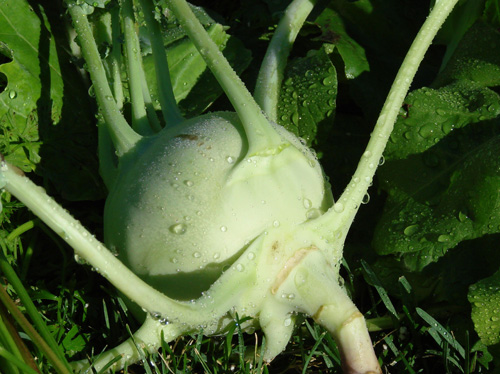 Kohlrabi
Kohlrabi© Michelle Mattern
Kohlrabi is a member of the cabbage family that is treated as a root vegetable.
It is a cabbage with an enlarged, turnip-shaped stem which is referred to as a bulb. The bulb grows above ground, just on the surface of the soil. With the stems sticking out of the bulb, it looks a bit like a 1950s science fiction satellite. The bulb is actually an underground stem that swells so that it grows partly above the surface.
The skin can be greenish or purplish. The greenish skin types are called “White Kohlrabi.” Purplish-skinned Kohlrabi is sometimes called “violet”, and other times called “red.” Inside, regardless of skin colour, both types are white.
The plant will only produce seed if left in the field over winter.
If the bulb is left to grow too big, it becomes tough with a strong flavour. When young, it will be sweeter with a milder flavour. Kohlrabi can be harvested young within 70 days after planting from seed.
Kohlrabi leaves are ruffled. Leaves on the violet types are darker. The leaves can be cooked separately as greens, if you are harvesting the Kohlrabi young (as you want to, anyway.) Kohlrabi greens have many fans.
Green varieties include Eder, Express, Grand Duke, Komet and Superschmelz. Violet varieties include Kolibri and Rapid. Older varieties such as Purple Vienna and Green Vienna tended to get woody.
When buying fresh Kohlrabi, choose small, firm bulbs about the size of a tennis ball (5 to 7.5 cm wide — 2 to 3 inches) with fresh leaves, if the leaves are indeed still attached.
Cooking Tips
Kohlrabi
© Denzil Green
Kohlrabi can be fried slowly in butter, or steamed or boiled, or prepared as you would turnip. A light, satisfying mash can also be made from them.
Kohlrabi are often served with a white sauce with nutmeg. Many recipes will have you hollow out the middle, fill with a stuffing and then bake.
Raw Kohlrabi can be grated for use in salads.
Very small Kohlrabi don’t really need peeling; older ones do.
To peel, slice off the bottoms which will be woody, then peel the thick skin down until the fibrous, “vein-like” layer under the skin has been also removed — it won’t soften during cooking, and is annoying if it catches in your throat. You’re done peeling when you just see a light layer of crisp flesh.
Boil for 10 minutes or steam for 12. In a pressure cooker, 6 to 7 minutes on high.
To microwave, peel and slice medium Kohlrabis. Place in microwave-proof dish with some water (for 4 to 5 Kohlrabi, about ¼ cup / 2 oz / 60ml). Nuke on high for 10 to 15 minutes, stirring occasionally, then let stand covered for 5 minutes.
Kohlrabi greens: cut off and discard the stems keeping only the actual leaves, cook in boiling water until just tender, then sauté in olive oil and garlic for a few minutes.
Equivalents
2 pounds Kohlrabi = 900g = 4 medium bulbs = 3 ½ cups peeled, cubed, cooked
Storage Hints
If your Kohlrabi came with leaves attached, remove the leaves before storing the bulbs in the fridge. Store roots in refrigerator crisper in plastic bags for up to 3 weeks.
Freezing: Cut off roots and top. Wash and peel. Leave whole and blanch 3 minutes; or cut into ½ inch (1 cm) cubes and blanch 1 minute. Plunge in cold water, drain, package, and freeze.
History Notes
Originated in northern Europe around the 1500s. First described in 1554. Grown on a large scale in Ireland in 1734 and in England by 1837. Grown in America by 1806.
Language Notes
Kohlrabi is two German words put together. “Kohl” means cabbage; “rabi” means “turnip”.


